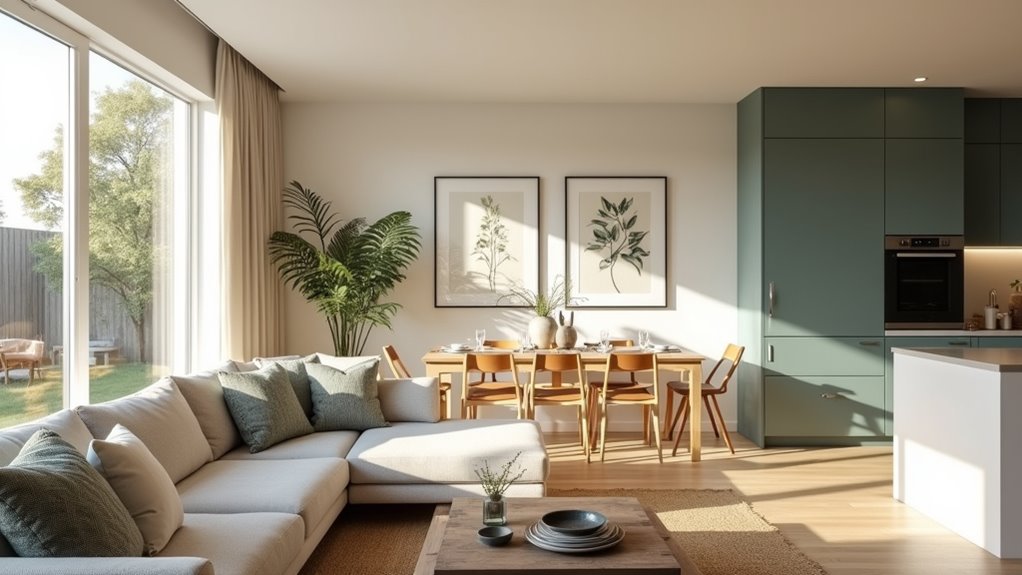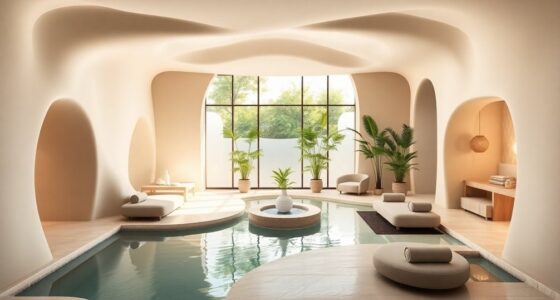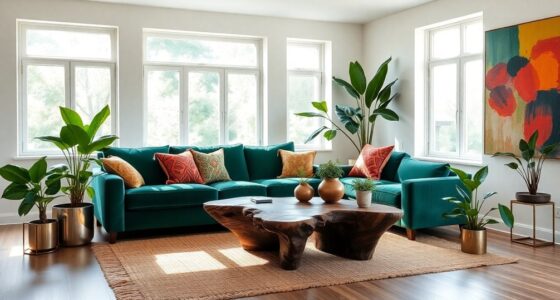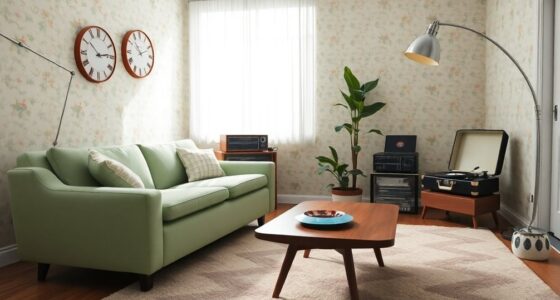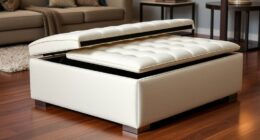Creating a cohesive style throughout your home involves unifying design elements like color, texture, and materials. Start by choosing a consistent color palette of 3-5 complementary colors to anchor each space. Incorporate similar textures and materials for continuity, such as wood or stone, and repeat design elements across rooms. By thoughtfully layering these aspects, you’ll foster a harmonious flow throughout your home. Want to learn more about achieving that perfect look? There are a few practical tips to contemplate!
Key Takeaways
- Establish a consistent color palette of 3-5 complementary colors to ensure visual harmony throughout your home.
- Incorporate similar materials and textures across different rooms for a unified aesthetic appeal.
- Use repeating design elements, such as cabinetry styles or fixtures, to create architectural continuity.
- Define distinct areas in open spaces with area rugs and unique lighting while maintaining overall unity.
- Curate unique decor items that reflect personal style but share common colors or materials for cohesive flow.
Understanding Cohesion in Home Design
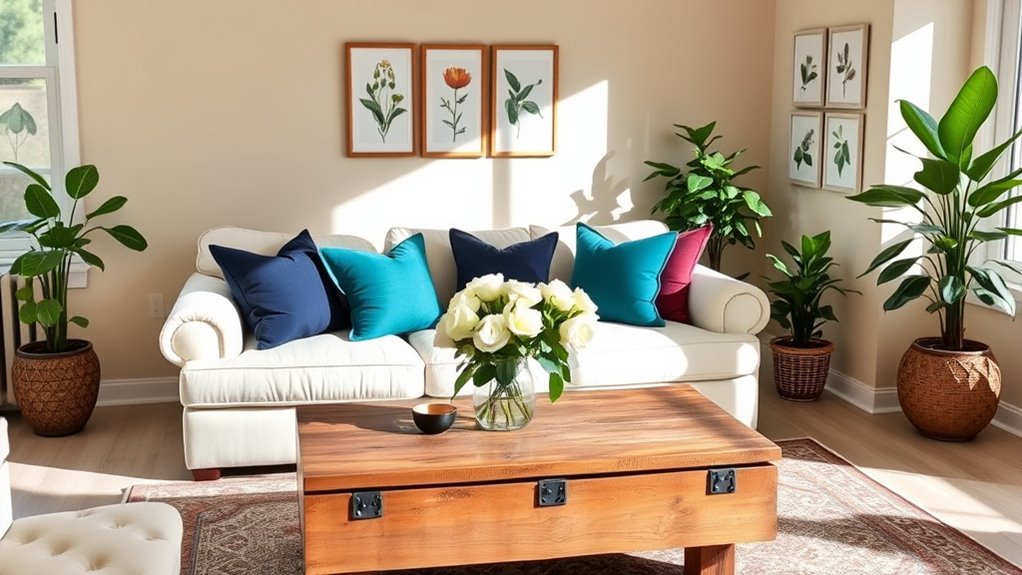
Cohesion in home design is essential for creating a harmonious living space, as it allows you to feel a sense of connection throughout your home. To achieve a cohesive look, you’ll want to repeat design elements across different rooms.
This includes using a consistent color palette, typically limited to 3-5 complementary colors, which helps unify spaces and prevents visual chaos. You can also select materials and decor that share similar styles or feelings, linking the aesthetics of each room. For example, incorporating natural materials like wood and stone can enhance the overall warmth and authenticity of your home. Additionally, consider using durable materials in your design, which can provide longevity and maintain the aesthetic appeal throughout your space.
Incorporating era-specific decor or furniture can enhance this connection, providing a seamless flow through your interior design. By thoughtfully blending different styles while maintaining these core elements, your home will exude comfort and familiarity. Furthermore, the inclusion of vintage or distressed furniture can add character and authenticity to your design. Additionally, the use of natural elements can further promote tranquility and enhance the overall cohesive style of your home.
Establishing a Consistent Color Palette
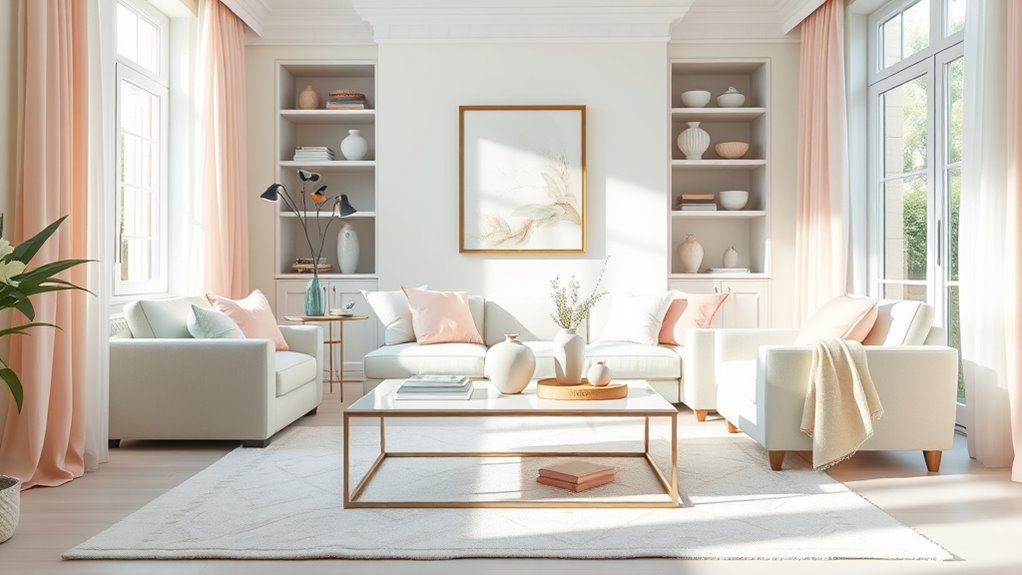
When establishing a consistent color palette, start by choosing your base colors that will anchor your spaces. Next, incorporate a few accent hues to bring life and vibrancy to your home. Don’t forget to test color combinations in different lighting to verify they create a harmonious flow throughout your rooms. Additionally, consider how color coordination can enhance overall room design and create a cohesive look. To achieve this, you can assess client needs to ensure that the chosen colors reflect their personal style and preferences, creating a more tailored environment. Incorporating elements like neutral color palettes can further enhance the calming atmosphere throughout your home. For instance, using warm color palettes can evoke a cozy and inviting ambiance, making your spaces feel more welcoming.
Choosing Base Colors
Establishing a consistent color palette can transform your home into a harmonious space that feels unified and inviting. Start by selecting a primary color that will dominate your design, ensuring it flows seamlessly from room to room. Incorporating innovative design ideas can help you visualize how colors interact within your space.
Here are some tips for choosing base colors:
- Choose a primary color to set the foundation for your color palette throughout the home.
- Limit your accent colors to 3-5 to maintain a cohesive aesthetic without overwhelming your decor.
- Use complementary colors to connect spaces, ensuring each room enhances its neighbor.
- Incorporate hues from artwork or textiles into your wall paint choices and furnishings for continuity. Natural materials can also play a key role in enhancing your chosen color scheme. Additionally, consider how creating seamless indoor-outdoor flow can influence your decision on colors by allowing natural light to enhance your palette.
Regularly reassess your color selections to align with your vision and the mood you want to create. Additionally, consider how floral arrangements can incorporate your chosen color palette, adding depth and character to your space.
Incorporating Accent Hues
Incorporating accent hues into your home design can elevate the overall aesthetic, bringing life and character to each space. Start by selecting a primary color that dominates your home, then complement it with 2-4 accent colors to create visual harmony.
Use similar hues in textiles, like rugs and pillows, to promote cohesion, ensuring these elements reflect your primary color. Accent hues can also be drawn from artwork or decor items, influencing wall paint choices and tying rooms together. Incorporating sticking wall decor can also enhance the visual impact of your chosen accent hues, ensuring that your artwork complements your color palette effectively. Additionally, integrating natural elements like wood or stone can further enhance the cohesion of your accent hues with the overall design. Utilizing mood boards during your planning phase can help visualize how these colors interact in your spaces.
However, limit the use of accent colors to avoid overwhelming your decor, enhancing rather than clashing with your overall scheme.
Finally, regularly assess how your chosen colors appear in different lighting conditions to maintain consistency and achieve your desired aesthetic. Incorporating energy-efficient appliances can also enhance your space while aligning with your color palette.
Testing Color Combinations
Testing color combinations is essential for creating a cohesive aesthetic in your home. Here’s how you can effectively establish a consistent color palette:
- Sample Paint Swatches: Test them in different lighting to see how colors change throughout the day. Additionally, consider how modern Energy Star certified fans can enhance airflow and contribute to a comfortable living environment while complementing your design choices. Incorporating natural materials can also add texture and warmth to your color scheme. Understanding how emotional stability can be reflected in your color choices may also aid in creating a more harmonious atmosphere.
- Use a Color Wheel: Identify complementary colors and limit your palette to 3-5 for a cohesive look.
- Incorporate Existing Decor: Pull colors from artwork or textiles to enhance your overall color palette.
- Create a Vision Board: Visualize how your color choices interact, ensuring they align with the desired mood and style of each room.
Regularly reassessing your color choices with feedback from friends and family can help maintain a cohesive color scheme that truly reflects your style. Additionally, considering seasonal variations in color can further enhance the harmony of your home’s aesthetic.
Incorporating Similar Textures and Materials
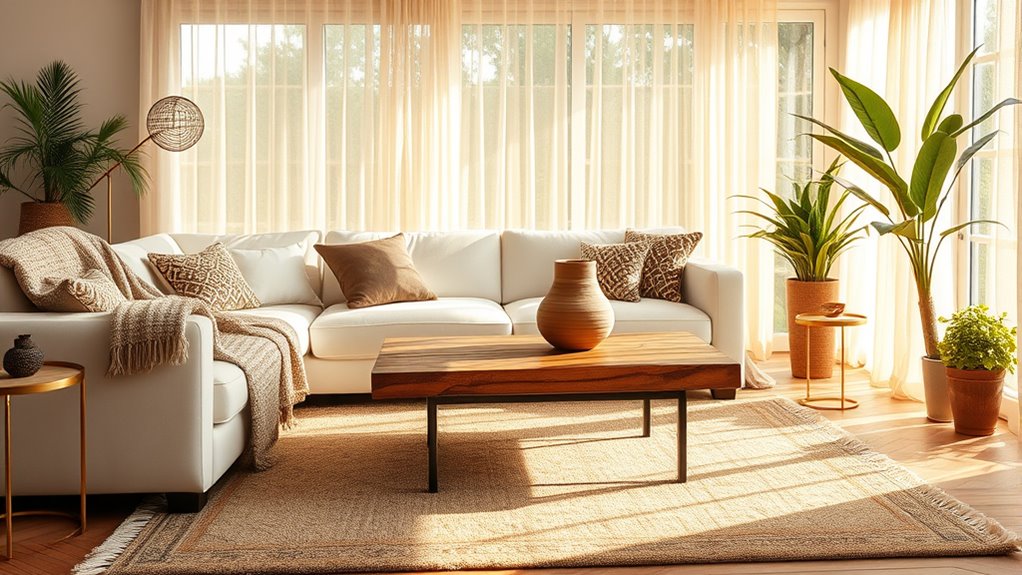
When you incorporate similar textures and materials throughout your home, you create a seamless flow that enhances its overall beauty. Repeating elements like wood or metal fixtures can visually connect different spaces while establishing a cohesive theme. Additionally, unique textures can add depth and interest, further enriching the aesthetic experience. For instance, incorporating energy-efficient designs can not only elevate your home’s style but also contribute to a more sustainable living environment.
Repeating Material Choices
By selecting similar textures and materials throughout your home, you can create a cohesive and inviting atmosphere. Here are some ways to achieve that:
- Use repeating materials like wood, metal, or stone across different rooms to unify diverse design styles.
- Incorporate textiles such as velvet or linen consistently to enhance the overall aesthetic.
- Choose hardware and fixtures in the same finish, like brushed nickel or matte black, to tie spaces together.
- Use a common color or texture in decorative items, such as throw pillows or area rugs, to reinforce a cohesive look.
These strategies help you establish a seamless connection, making your home feel harmonious and thoughtfully designed.
Textural Harmony Across Spaces
To achieve textural harmony across your home, consider how similar textures can create a seamless flow between spaces. Incorporating materials like velvet, linen, or wood finishes fosters continuity and a cohesive atmosphere.
By utilizing a consistent material palette, such as varying shades of hardwood flooring or a specific tile, you enhance visual harmony throughout your decor. Layering textures, like soft fabrics with harder surfaces, adds dynamism while keeping a unified design language.
When selecting decor, choose items with matching tactile qualities, like matte versus glossy finishes, to reinforce this cohesive look. Thoughtfully combining textures, such as pairing a plush area rug with sleek furniture, bridges different styles and strengthens your overarching design theme.
Designing Open Concept Spaces for Flow
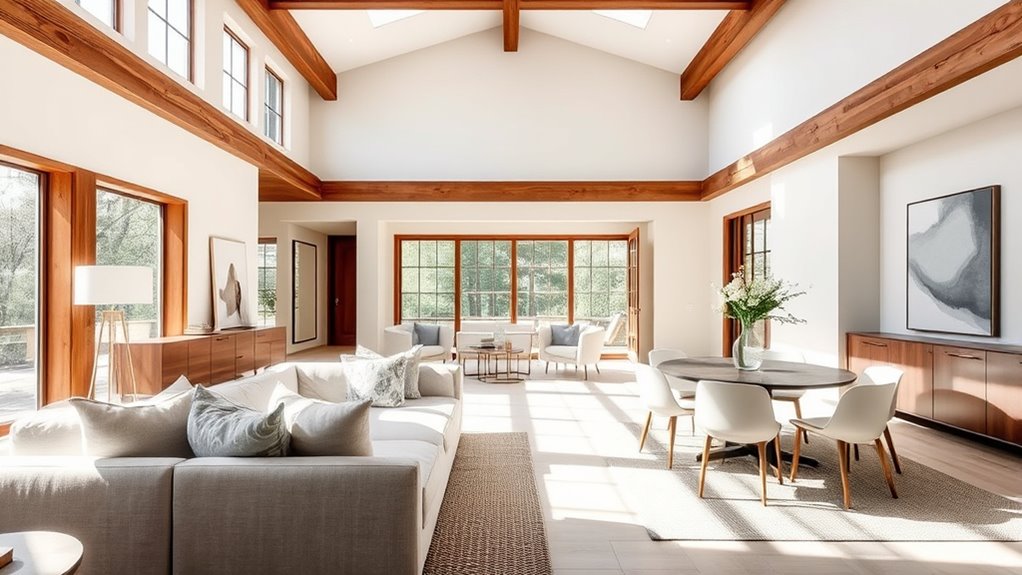
Creating a harmonious flow in open concept spaces requires thoughtful design choices that unify adjoining areas.
To achieve a cohesive home, consider these strategies:
- Consistent color palette: Use complementary colors throughout to enhance visual harmony.
- Repeating design elements: Incorporate similar cabinetry styles and materials to tie spaces together.
- Defined areas: Utilize area rugs and unique light fixtures to create distinct zones while maintaining unity.
- Architectural continuity: Employ consistent millwork or trim to establish a seamless look.
Balancing Individuality With Cohesion
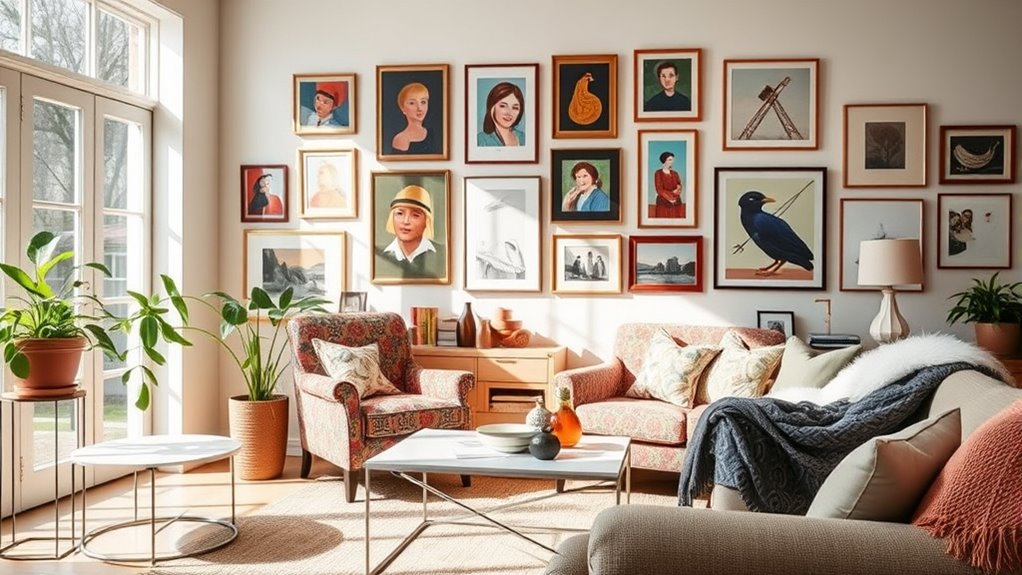
How do you strike the right balance between individuality and cohesion in your home? Start by choosing a consistent color palette of 3-5 colors to create a cohesive flow. Use unique decor items that reflect your style while sharing common elements like materials or textures. This fosters visual connections across spaces.
In open concept areas, define distinct spaces with variations in decor and furnishings, ensuring they align with a common theme. Embrace eclectic design by curating collections based on color or material. This not only showcases your personal taste but also reinforces a cohesive aesthetic throughout your home.
| Cohesion Strategies | Individuality Examples |
|---|---|
| Consistent color palette | Unique decor items |
| Repeating design elements | Personal collections |
| Defined spaces | Eclectic design styles |
| Shared materials | Customized furnishings |
Addressing Non-Cohesive Areas
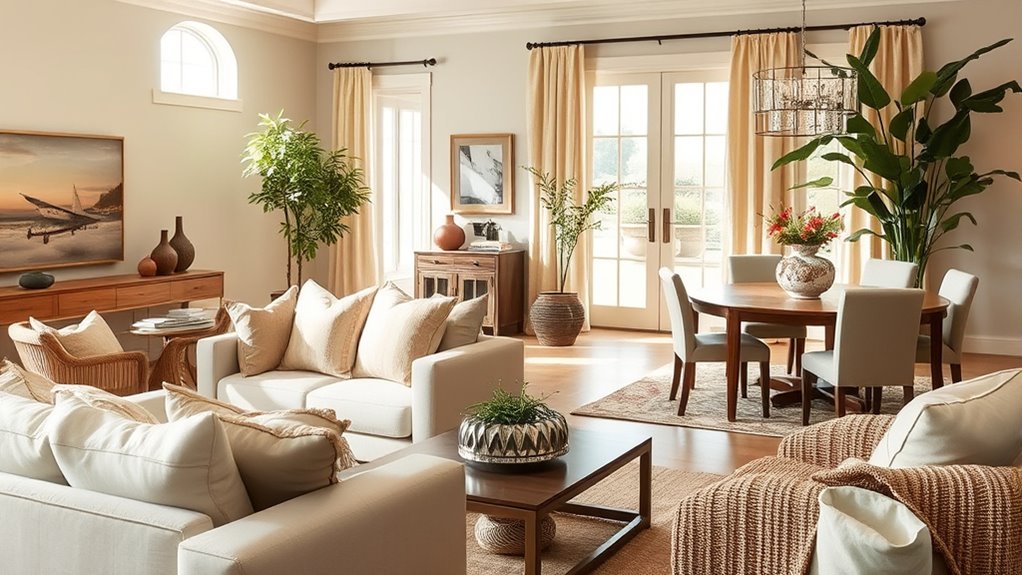
Even if certain areas of your home, like basements or outbuildings, seem disconnected, you can still foster a sense of unity by incorporating shared design elements.
Foster unity in your home by using shared design elements, even in seemingly disconnected areas.
To address non-cohesive areas, consider these strategies:
- Color Palettes: Use a consistent color scheme that flows throughout your spaces.
- Materials: Choose similar materials for flooring or finishes to connect styles.
- Furniture: Select pieces that bridge the gap between modern additions and older features.
- Attention to Detail: Standardize door styles and architectural finishes for a polished appearance.
Practical Tips for Achieving a Unified Look
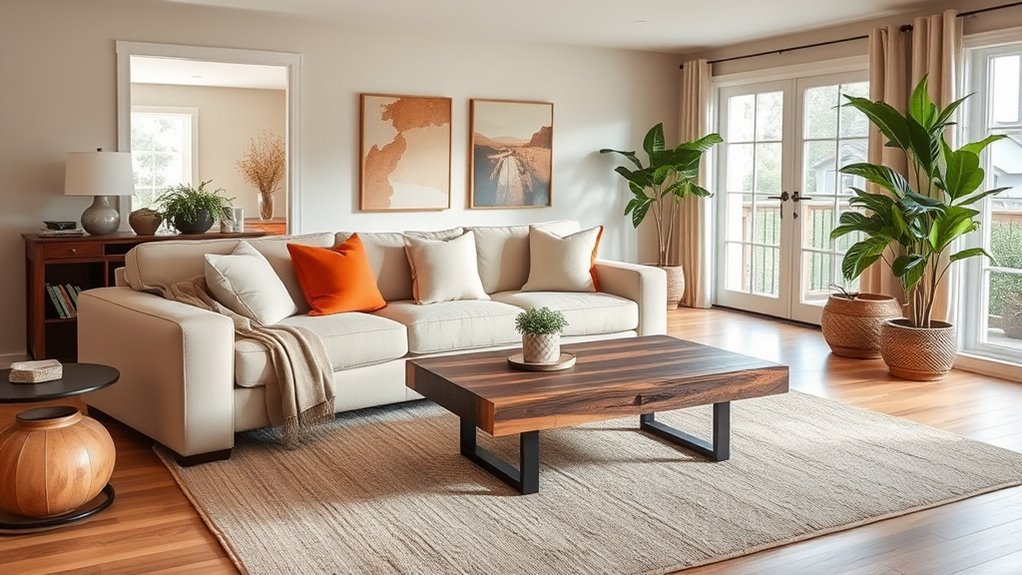
While achieving a unified look may seem intimidating, it can be accomplished with thoughtful design choices that connect your spaces. Start by selecting a consistent color palette with 3-5 complementary colors, enhancing each room’s aesthetic.
Repeat key design elements like light fixtures and textiles—think velvet or linen—to create visual ties across your home. Incorporate similar materials and textures, such as using the same tile variety in kitchens and bathrooms, to enhance design flow.
Define open areas with area rugs and unique light fixtures while maintaining a cohesive style. Finally, regularly reassess your choices, editing out clutter and ensuring every piece contributes positively to your home’s cohesive look.
With these tips, you’ll create a harmonious environment effortlessly.
Frequently Asked Questions
How to Create a Cohesive Look in Your Home?
To create a cohesive look in your home, start by choosing a consistent color palette of 3-5 complementary colors.
Repeat design elements like materials and textures across different rooms. Incorporate similar textiles and patterns in your furnishings to promote unity.
For open spaces, use cabinetry styles that match while defining areas with rugs and unique light fixtures.
Regularly assess your choices to verify they align with your vision, enhancing the overall aesthetic.
What Is a Cohesive Style?
A cohesive style is all about creating a harmonious look that connects different spaces in your home.
It involves using a consistent color palette and repeating design elements that work well together. By selecting compatible styles and incorporating similar materials, textures, and patterns, you can guarantee each room feels intentional and unified.
This approach not only enhances the visual flow but also makes your home feel welcoming and reflective of your personal taste.
How to Style a Whole House?
To style your whole house, start by choosing a consistent color palette that ties each room together. Limit your selection to 3-5 complementary colors.
Incorporate similar materials and textiles to enhance unity, like matching fabrics for cushions and curtains. Use architectural features consistently, and repeat cabinetry styles in open-concept spaces.
Regularly assess your decor, grouping items by color or material to maintain balance and eliminate clutter, ensuring every piece fits your home’s overall vibe.
How to Combine Decorating Styles for a Cohesive Look?
Imagine your home as a well-composed symphony, where each instrument plays harmoniously.
To combine decorating styles for a cohesive look, start by establishing a color palette of 3-5 complementary hues. Use common materials and textures to create continuity, and incorporate key design elements that share a common aesthetic.
Layer patterns thoughtfully, balancing busy designs with simpler ones, and develop a narrative that weaves your eclectic pieces into a unified story.
Conclusion
In home design, remember that “variety is the spice of life,” but too much can create chaos. By following the principles of cohesion—like a consistent color palette, similar textures, and open spaces—you can create a harmonious environment that reflects your personal style. Don’t shy away from individuality, but guarantee it complements your overall design. With a few practical tips, you can achieve a unified look that feels both inviting and uniquely yours.
